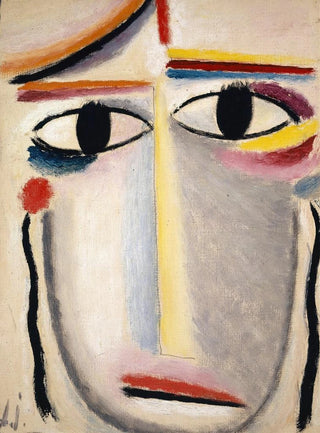Art print | Woman's head - Alexej von Jawlensky


View from behind

Frame (optional)
In the fascinating world of modern art, some works stand out for their ability to capture the human essence while transcending traditional forms. "Head of a Woman" by Alexej von Jawlensky is one of those iconic pieces that evoke emotional depth and reflection on identity. This artwork, both simple and complex, invites us to explore the nuances of femininity through the lens of an artist deeply influenced by Expressionist and Fauvist movements. Immersing ourselves in this creation, we discover not only a portrait but also a dialogue between the artist and the viewer—a silent conversation that resonates across time.
Style and uniqueness of the work
Jawlensky's style is characterized by bold use of colors and shapes. In "Head of a Woman," he opts for simplified features and vivid colors that evoke emotional intensity. The contours of the face, though stylized, retain an expressiveness that draws the eye and captivates the mind. The vibrant hues, ranging from deep reds to soothing blues, create an atmosphere that is both warm and unsettling. This chromatic choice, far from being trivial, reflects the artist's desire to transcend mere representation and touch the very essence of subjectivity. The artwork thus invites introspective contemplation, where each viewer can project their own emotions and reflections onto this enigmatic female figure.
The artist and his influence
Alexej von Jawlensky, a major figure of the early 20th century, mastered blending various artistic influences to forge his own visual language. Raised in a rich cultural context, he was influenced by Fauvism and Expressionism, two movements that advocate for expressing emotions through color and form. Encounters with artists such as Wassily Kandinsky and Marianne von Werefkin also nourished his creative approach. In "Head of a Woman," Jawlensky does not merely reproduce an image; he seeks to capture an essence, an emotion, an inner truth. His work resonates with the concerns of his time, while

Matte finish

View from behind

Frame (optional)
In the fascinating world of modern art, some works stand out for their ability to capture the human essence while transcending traditional forms. "Head of a Woman" by Alexej von Jawlensky is one of those iconic pieces that evoke emotional depth and reflection on identity. This artwork, both simple and complex, invites us to explore the nuances of femininity through the lens of an artist deeply influenced by Expressionist and Fauvist movements. Immersing ourselves in this creation, we discover not only a portrait but also a dialogue between the artist and the viewer—a silent conversation that resonates across time.
Style and uniqueness of the work
Jawlensky's style is characterized by bold use of colors and shapes. In "Head of a Woman," he opts for simplified features and vivid colors that evoke emotional intensity. The contours of the face, though stylized, retain an expressiveness that draws the eye and captivates the mind. The vibrant hues, ranging from deep reds to soothing blues, create an atmosphere that is both warm and unsettling. This chromatic choice, far from being trivial, reflects the artist's desire to transcend mere representation and touch the very essence of subjectivity. The artwork thus invites introspective contemplation, where each viewer can project their own emotions and reflections onto this enigmatic female figure.
The artist and his influence
Alexej von Jawlensky, a major figure of the early 20th century, mastered blending various artistic influences to forge his own visual language. Raised in a rich cultural context, he was influenced by Fauvism and Expressionism, two movements that advocate for expressing emotions through color and form. Encounters with artists such as Wassily Kandinsky and Marianne von Werefkin also nourished his creative approach. In "Head of a Woman," Jawlensky does not merely reproduce an image; he seeks to capture an essence, an emotion, an inner truth. His work resonates with the concerns of his time, while






